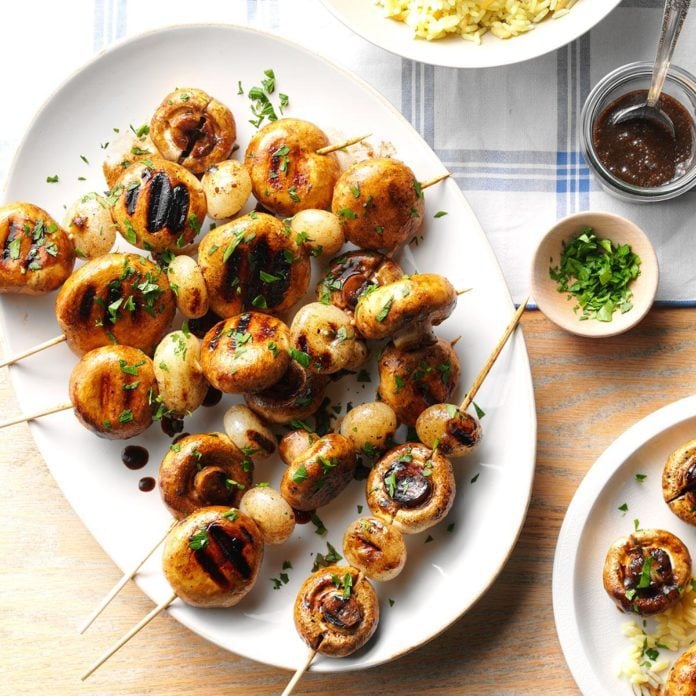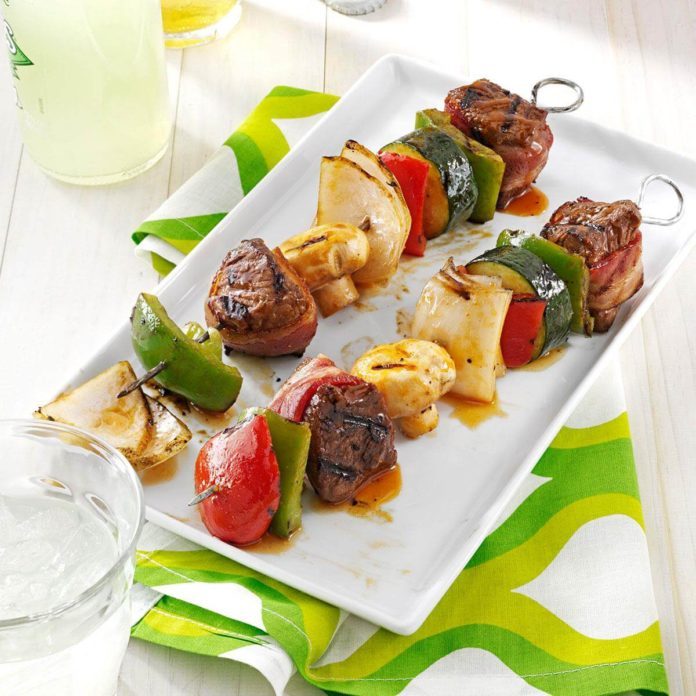Grilling kabobs is one of our favorite summer activities. It’s a no-fuss way to cook up meat and vegetables without dirtying (or heating) the kitchen. Serve them on their own for a complete meal, or drizzle them with a killer sauce and round things out with an easy side dish. No matter how you serve kabobs, they’re always delicious.
We have so many easy grilled kabob recipes, but you can also learn how to grill kabobs without a recipe. Read on to learn everything you need to know about grilling the best-ever kabob.
The No. 1 Mistake in Kabob-Making
First things first: We’d like to dispel a common kabob-making myth. Multicolored kabobs loaded up with alternating pieces of meat and vegetables look gorgeous, but you’ll end up sacrificing flavor for beauty. Meat and vegetables cook at different rates, so it’s better to make separate skewers for meat, poultry, seafood and vegetables. It’s OK to combine items with similar cooking times—like onions and peppers—but it would be a mistake to put potatoes and shrimp on the same skewer.
The Best Ingredients for Kabobs
Kabobs are fantastic because they’re so versatile. If you can skewer it, you can probably make a kabob out of it! That said, some meats and vegetables make better kabob options than others.
Meat and Poultry
Look for quick-cooking meats that work well with direct-heat grilling. That means beef steak cuts like filet mignon, ribeye, New York strip or sirloin are great choices, as are chicken breasts, chicken thighs, sausage, bacon, pork chops or pork tenderloin. Avoid tough cuts like beef brisket or pork shoulder, which won’t break down and become tender in time. Lamb seems to be the one exception to this rule. We’ve made kabobs out of the loin, leg and shoulder, and they all turn out great.
Seafood
You’ll want to choose a firm-textured fish that won’t flake apart on the grill. Look for swordfish, tuna, salmon, halibut, mahi mahi, snapper or monkfish, avoiding thin or delicate fish like walleye, trout, sole and flounder. If you can buy the fish in steaks, all the better; they’ll be easier to cut into cubes. Other types of seafood that work with kabobs include shrimp, scallops, lobster tail and squid.
(Psst: These are the best fish to buy when you can’t find tuna or halibut.)
Vegetables
Most vegetables are fair-play for kabobs, as is firm, pressed tofu. Red onions and bell peppers are a classic choice for their bright burst of color, but you can’t go wrong with mushrooms, zucchini, yellow squash or cherry tomatoes. Don’t be afraid to think outside the box with veggies like eggplant, broccoli, cauliflower, Brussels sprouts, carrots, sweet potatoes, winter squash and beets. That said, some vegetables don’t skewer as easily. We’ve found that skinny asparagus, green beans, cabbage wedges and segments of corn on the cob are easier to grill using other methods.
It’s also worth noting that, unlike meat, it’s best to grill vegetables over indirect heat (especially the longer-cooking root vegetables). When the veggies are cooked through, you can pop the kabob onto the direct heat side to add some char and color.
Marinades for Kabobs
A good marinade will not only flavor your kabob, but it will also tenderize the meat and keep it juicy and moist as it cooks. You’ll want to make sure your marinade contains oil to coat the ingredients and help the marinade stick to the food’s surface. Salt is another essential ingredient because it helps the meat retain moisture and adds seasoning. Adding an acidic ingredient like citrus juice or vinegar will also help tenderize the meat by breaking down tough muscle fibers. Feel free to include other aromatic ingredients, like spices, herbs or garlic, to add extra flavor.
When it comes to marinating meat and vegetables, it’s best to keep them separate. You can use one marinade recipe, but divide it into two different bags to prevent cross-contamination, even if you’re cooking the components together on a single skewer. They may also need different marinade times, and over-marinating meat or vegetables can cause them to turn mushy.
Here’s a handy guide for how long to marinate kabob ingredients:
- Beef, Chicken, Lamb and Pork: 2 to 24 hours
- Fish and Shrimp: 15 to 30 minutes
- Scallops: 15 minutes
- Firm tofu: 30 minutes
- Vegetables: Hard vegetables can marinate for anywhere from 30 minutes to 24 hours; soft vegetables should be kept to 15 to 30 minutes.
Need inspiration? Check out this collection of our favorite marinades for grilling.
How to Prep Your Kabobs
Prepping kabobs is easy in theory. Simply cut your meat and vegetables, plop ’em in the marinade and thread them on skewers. There are a few things you’ll want to look out for to ensure your kabobs cook evenly, though.
For starters, it’s important to cut the ingredients into similar sizes. A large chunk of beef cooks much more slowly than a small one, so choose your size and be consistent. We like 1-1/2 to 2-inch cubes best for most meat and seafood. Smaller pieces can cook too quickly and dry out, and larger pieces won’t cook all the way through over direct heat.
Then, when you’re ready to load the ingredients onto the skewer, focus on spacing. If the meat and vegetables are packed too closely together, air won’t be able to circulate between the pieces. The ends of the skewer could overcook and dry out by the time the middle pieces are cooked through. Instead, leave about 1/2-inch of space between each piece.
Finally, most ingredients can be threaded onto a single skewer, but top-heavy ingredients like shrimp can be annoying, spinning around instead of flipping easily. Don’t be afraid to thread these types of ingredients onto two skewers to increase stability.
How Long to Grill Kabobs
In general, kabobs usually take 10 to 15 minutes to cook. We’re making a few assumptions here: the cubes are 1-1/2 to 2-inches thick and the kabobs will be cooked over direct heat on a grill set to medium-high temperatures (about 400°F).
Keep in mind that kabobs will cook more quickly if the ingredients are cut into smaller pieces, and more slowly if the temperatures are low. It’s also best to flip the kabobs several times to give them the opportunity to brown on each side.
If you’re looking for more specifics, use an instant-read thermometer. The internal temperature of meat, poultry and seafood is the best way to know (not guess) that the kabobs are finished cooking. Here are the temperatures to shoot for:
- Beef: 130°F for medium-rare, 140°F for medium
- Chicken: 165°F
- Fish: 130°F, although salmon can be cooked to 120°F for medium-rare and sushi-grade tuna should be cooked to temperatures below 115°F
- Lamb: 130°F for medium-rare, 140°F for medium
- Pork: 140°F for medium, 150°F for well-done
- Scallops: 115°F
- Shrimp: 120°F
- Firm Tofu: No specific temperature; tofu is done when it’s lightly crisped up and warmed through to the center
- Vegetables: No specific temperature; vegetables are done when they’re tender and have the desired charred characteristic
How to Prep Your Grill
Whether you’re using a gas, charcoal or electric grill, you’ll want to follow the same procedure for preparing the grill for kabobs. The best way to keep the kabobs from sticking is to preheat the grill in advance, closing the cover for about 15 minutes to get the grill grates as hot as possible. This helps loosen up any built-on bits, making it easier to clean the grates. Then, before you add your kabobs, oil the grates to add an extra layer of stick prevention. Always oil hot grates moving from the back to the front to keep the flare-ups from burning your arms.
Essential Tools to Recommend
You can’t make kabobs without skewers, so you’ll have to decide which you want to use: stainless steel or wood skewers. Stainless steel skewers are best for longevity, and they don’t need to be soaked in advance. Wood skewers, on the other hand, have to be soaked for two hours before grilling to keep them from burning, but they’re disposable, which makes cleanup a breeze.
We like 14-inch flat stainless steel skewers best for anyone who makes kabobs on the regular. Unlike round skewers, they prevent most ingredients from spinning as you turn them. They’re also easier to use than curved or flexible skewers.
For wooden skewers, we look to 12-inch round bamboo skewers. Bamboo is a sustainable wood choice, and it holds up well to the grill’s heat after a few hours of soaking. They’re also inexpensive, so you won’t mind throwing them away when you’re done.
Grilling kabobs is simple, so you don’t need a ton of tools, but it’s not a bad idea to pick up a silicone basting brush. We sometimes skip the marinade step for simple vegetable skewers, and this tool makes it easy to brush them with sauce as they cook.
How to Make Kabobs
Kabob making allows you to play around with different ingredients and marinades, so there’s no one hard-and-fast kabob recipe. Here are some tips for making the best kabobs.
Steak Kabobs
Red meat can hold up to bold marinades, so have some fun when making steak kabobs. We like this grilled beef marinade with French dressing, Worcestershire and lemon juice. Once you’re ready to cook, it’s important to flip steak kabobs every three to four minutes, ensuring that each side of the cube gets a beautiful char. Since steak can be cooked to medium-rare temperatures, have the thermometer ready. You don’t want to overcook lean cuts like filet mignon!
Chicken Kabobs
Chicken breasts are a great choice for kabobs, but they’re very lean and dry out more quickly than chicken thighs. Make sure to use a great marinade to protect the chicken, like this honey-glazed version. Undercooked chicken is dangerous, too, so use a thermometer or cut into the chicken to be sure it’s cooked through before serving.
Vegetable Kabobs
If you decide to skip the marinade with veggie kabobs, you can still flavor them by brushing them with a sauce as they cook. We like this recipe that uses lemon juice and soy sauce. Quick-cooking vegetables like zucchini and tomatoes will do fine over direct heat, but we recommend indirect heat for most vegetable skewers. And if you’re working with thin vegetables—like green beans or asparagus—don’t be afraid to use two skewers to make the kabob easier to flip.
Seafood Kabobs
Seafood kabobs cook fast, especially if you’re using pieces smaller than 1-1/2 inches. You’ll want to pay close attention to the color of the seafood to identify when it goes from translucent to opaque. Seafood can be difficult to skewer, too. We’ve found the best way to skewer shrimp is to lay them flat and push the skewer directly through the middle, piercing both the tail and the head end. If it’s still a frustrating flipping experience, try adding a second skewer to add stability.
The post How to Grill Kabobs appeared first on Taste of Home.
Lindsay D. Mattison

































